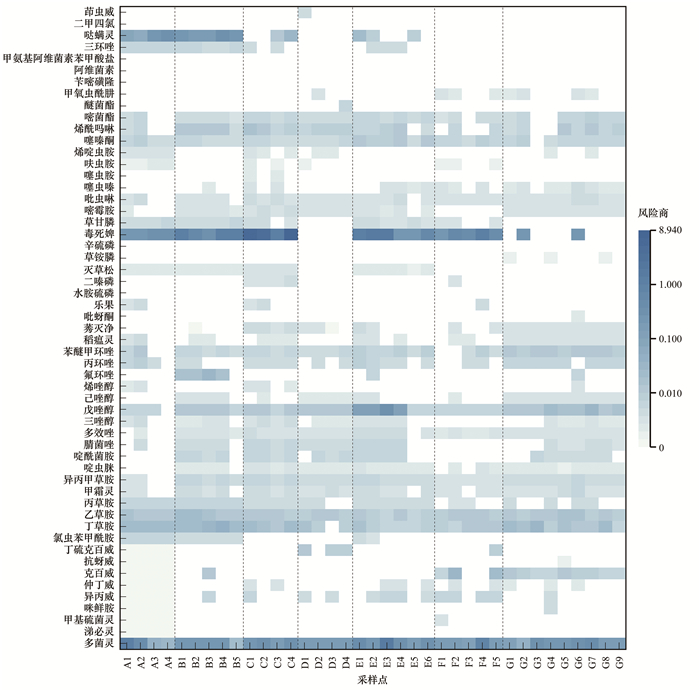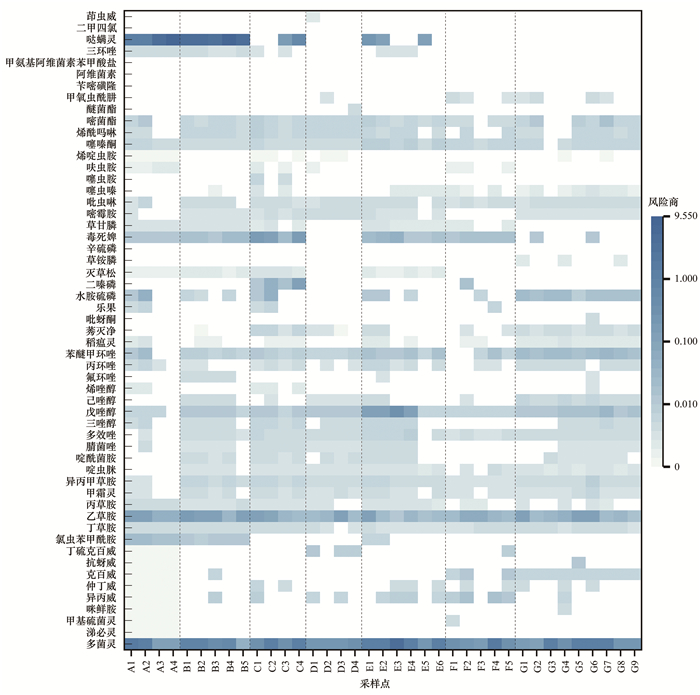2. 哈尔滨工业大学(深圳)土木与环境工程学院, 城市水资源与水环境国家重点实验室, 深圳 518055;
3. 中国科学院生态环境研究中心饮用水科学与技术重点实验室, 北京 100085
2. State Key Laboratory of Urban Water Resource and Environment, School of Civil and Environmental Engineering, Harbin Institute of Technology (Shenzhen), Shenzhen 518055, China;
3. Key Laboratory of Drinking Water Science and Technology, Research Center for Eco-Environmental Sciences, Chinese Academy of Sciences, Beijing 100085, China
农药是在农业生产中防止植物和农作物遭受例如病原体、真菌、害虫和杂草危害的化学药品.全球农药的生产和使用随着时间的推移逐渐增长[1].农药中含有一种或多种活性物质, 残留农药可以通过地表径流或农田排水进入地表水体, 或渗入土壤污染地下水[2~4], 进而对整个生态系统结构、功能以及人类健康产生严重危害[5~9].
农药在水生环境中还可能引起鱼类种群的生理行为变化[10].农药浓度的增加可能导致鱼类种群数量减少[11].此外, 源水和饮用水中农药的出现可能与白血病、脑癌、淋巴瘤、乳腺癌、前列腺癌、卵巢癌和睾丸癌有关[10].大部分农药可能会造成中度甚至重度的呼吸系统和神经系统损伤[12].目前, 尽管有学者研究出了相对安全的农药来替代高毒性农药, 但其水生环境污染问题还远远没有得到解决[13].水库水作为饮用水供给链的前端, 是保证居民用水安全的重要一环.因此, 有必要调查农药在水库水中的浓度水平和生态风险.
本研究以我国东南某省某地区7个水库为目标区域, 在每个水库设置4~9个采样点.采用超高效液相色谱串联三重四极杆质谱仪对55种农药进行检测分析, 并系统评估该区域55种农药的生态风险, 在此基础上提出了针对该地区的饮用水环境风险管理建议.
1 材料与方法 1.1 样品采集与保存本研究于2021年6月采集东南某省7个水库样品, 分别编号为A、B、C、D、E、F和G.每个采样点采集5 L水样并装入预先清洗过的琥珀色玻璃瓶, 4℃储存后运送入冷库保存, 3d内进行过滤和固相萃取等前处理.
1.2 样品制备与分析用于样品制备和分析的其他化学试剂均为HPLC级或分析级.水样通过固相萃取(SPE)进行富集, 使用Oasis HLB固相萃取柱(Waters, Millford, MA, USA).固相萃取前, 水样通过1 μm玻璃纤维滤膜(GF/B, Whatman, Mainstone, England)过滤, 然后用40%(体积分数)H2SO4酸化至pH 3.0, 最后用0.5 g ·L-1 Na2EDTA螯合.固相萃取柱需要提前活化[5 mL甲醇+5 mL稀盐酸(1 ∶23)+5 mL超纯水], 使用固相萃取柱富集每个水样(1.0 L)并用4 mL×4甲醇洗脱, 然后用高纯度氮气将样品吹脱至400 μL.进样前, 用超纯水将样品复溶至1 mL.提取的水样用超高效液相色谱串联三重四极杆质谱仪(UPLC-MS/MS)(带电喷雾离子源)(Agilent 1290/6420 UPLC-MS/MS, Agilent, USA)进行分析; 使用C18柱进行目标分析物的色谱分离, 具体操作参数见表 1.
|
|
表 1 超高效液相色谱串联三重四极杆质谱仪(带电喷雾离子源)工作参数 Table 1 Operating parameters of the ultra-performance liquid chromatography-triple quadruple mass spectrometer (with electrospray ion source) |
1.3 质量保证和质量控制
在确定的保留时间内, 根据母离子和两个丰度最高的产物离子完成对目标农药的定性分析.在样品分析前, 通过测量农药回收率、检测和量化极限以及回归系数来进行方法验证.磷酸三苯酯作为内标物在仪器分析前加入每个预处理的样品中, 以监测仪器分析中的底物效应.配置不同浓度梯度的混合标准溶液(0.1~2 000 ng ·L-1), 用于绘制每个目标物的标准曲线, 用内标法进行定量分析.在样品中加入0.1、0.5、1、10、50、100、500和1 000 ng ·L-1的混合标准溶液, 按照优化方法进行平行实验(n=3), 计算目标物的回收率和相对标准偏差(RSD).
55种目标农药的平均回收率在78.62% ~123.62%之间, RSD在2.10% ~21.30%之间.每种农药的LOD和LOQ分别被定义为信号/噪声(S/N)为3和10时所对应的浓度.所建立的UPLC-MS/MS方法具有良好的相关系数(r2>0.99).
1.4 风险评估将每种农药的浓度作为实测环境浓度(MEC), 利用无观察效应浓度值(NOEC)来计算预测无效应浓度(PNEC).本研究参考Ogbeide等[14]和Papadakis等[15]的方法, 优先采用NOEC值, 当大部分目标农药的NOEC值不可得时, 采用半致死浓度(LC50)来代替NOEC值.具体公式如下所示.其中, 公式(2)中所有农药的NOEC值均由LC50代替.在对每种农药的分析中, 考虑了绿藻、水蚤和鱼类的慢性毒性数据, 并分别计算了不同的风险商(RQ).为了考虑从单一物种毒性推断到生态系统毒性所产生的不确定性, 通过将LC50值除以评估因子100计算PNEC值, 以评估农药的慢性毒性[16].LC50值通过美国环保署的模型(ECOSAR)计算得到[17].当水中的农药浓度较低时, 不存在急性毒性, 但其慢性毒性和各种农药的相互作用不容忽视[18].

|
(1) |

|
(2) |
式中, 当0.01≤RQ<0.10时, 该农药对目标生物的风险低; 当0.10≤RQ<1时, 为中风险; 当RQ≥1时, 为高风险[19].
2 结果与讨论 2.1 农药的检出频率和浓度水平东南某省饮用水源地主要检出的农药及其浓度见表 2.在55种农药中, 均未出现含量超过欧盟立法为饮用水中的单个农药规定的100 ng ·L-1限值.所有目标农药中, 多菌灵的检出浓度最高, 为77.7 ng ·L-1.类似地, 周怡彤等[20]在太湖流域西北部地表水的检测中也发现多菌灵的浓度最高[未检出(N.D.)~114.44 ng ·L-1].乙草胺、甲霜灵和异丙甲草胺的检出浓度次之, 分别为51.6、37.6和37.9 ng ·L-1.乙草胺在水生生态系统中具有较高的稳定性和持久性[21, 22].之前有报道提出乙草胺可以诱发斑马鱼的生殖毒性、免疫毒性和内分泌毒性[23], 因此可能对目标区域的鱼类等水生生物具有潜在危害.甲霜灵在中性和弱酸性的水体环境中表现出较高的稳定性[24], 这也是其检测浓度相对较高的原因.异丙甲草胺不仅会干扰植物细胞分裂的功能, 影响光合作用[25], 还会影响蝌蚪的隐藏行为[26].据统计, 东南某省2020年水稻种植面积为636.02×103hm2, 占全省总粮食作物耕种面积的64%[27], 而多菌灵、乙草胺、甲霜灵和异丙甲草胺作为广泛使用的杀菌剂和除草剂, 在水稻种植及生长过程中使用频繁且用量均较高.根据检测浓度可以看出, 水库中这4种农药微污染物很可能来源于环境残留.尤其是水库E和水库B的水源水, 多菌灵和乙草胺浓度有可能已经存在不同程度的污染, 这无疑对当地的水环境存在着不可忽视的潜在风险.
|
|
表 2 中国东南地区7个饮用水源地农药污染物浓度范围与检出频率 Table 2 Concentration ranges and detection frequency of pesticide pollutants in drinking water sources in southern China |
甲基硫菌灵、咪鲜胺、吡蚜酮、辛硫磷、醚菌酯、苄嘧磺隆和茚虫威则检出浓度相对较小, 尤其是有机磷类的辛硫磷和磺酰脲类中的苄嘧磺隆在目标水库中均未检出, 这可能是由于辛硫磷见光易分解, 残留期短[28], 而苄嘧磺隆在酸性条件下会缓慢水解[29~31], 且易于被土壤中的微生物降解[32~34].因此检测水体中的辛硫磷和苄嘧磺隆浓度均为0 ng ·L-1.
所分析目标农药的检出频率如表 2所示, 其中多菌灵和乙草胺的检出频率均为100%; 戊唑醇、噻嗪酮、丁草胺、异丙甲草胺、多效唑、苯醚甲环唑、吡虫啉、甲霜灵、嘧菌酯和啶虫脒的检出频率分别为97.37%、97.37%、97.37%、94.74%、89.47%、89.47%、89.47%、86.84%、84.21%和81.58%; 辛硫磷和苄嘧磺隆的检出频率为0%.
2.2 生态风险评估为了分析目标水库的RQ值变化, 选择了3种不同营养级的生物(绿藻、水蚤和鱼).如图 1所示, 多菌灵、毒死蜱和哒螨灵在不同目标水库对鱼类构成了不同程度的风险, 其中多菌灵在7个水库中存在生态风险的位点最多, RQ>1的位点有2个, 0.10≤RQ < 1的位点达34个, 共占总采样点的97.29%; 毒死蜱次之, 其中RQ>1的位点占29.73%, 0.10≤RQ < 1的位点占40.54%; 哒螨灵在水库A、B中满足0.10≤RQ < 1的位点占比为24.32%; 戊唑醇在水库E中构成了中风险, 位点占比为10.81%.这一现象与以前的研究相类似, 例如, 周怡彤等[20]研究太湖流域西北部地表水时发现, 在3月和8月时, 多菌灵对地表水生态环境呈高风险性; 陈诚等[35]在2018年的研究结果表明, 在我国扬州市江都区的稻田周边水体中, 毒死蜱对绝大多数水生动物(鱼、虾和蟹类)呈高或极高风险性; Ccanccapa等[18]的研究还发现, 戊唑醇对埃布罗河中的鱼类具有高风险(RQ=1.3).除多菌灵、戊唑醇和丁草胺外, 其他9种农药的检出频率虽然大于80%, 但其RQ值范围在0~0.01之间, 风险水平较低.

|
图 1 55种农药对鱼类的风险评估 Fig. 1 Risk assessment of 55 pesticides on fish |
对水蚤而言, 高风险农药主要包括多菌灵和哒螨灵, 如图 2所示.其中多菌灵仍然是生态风险覆盖最广的农药, RQ>1的位点占总采样点的43.24%, 0.10≤RQ < 1的位点达21个, 共占总采样点的56.75%.哒螨灵次之, RQ>1的位点有9个, 占比24.32%, 0.10≤RQ < 1的位点为5个, 占比为13.52%.另外, 乙草胺满足0.10≤RQ < 1的位点占比32.43%.多菌灵是一种被广泛使用的苯并咪唑类杀菌剂, 在淡水中具有较长的半衰期(25周)[36], Liu等[37]对长江中19种杀菌剂进行调查发现, 多菌灵在地表水和沉积物中始终构成中或高风险, 且位点占比为46.7%.多菌灵可诱发大型水蚤的DNA损伤(5.0 μg ·L-1)[38]、小鼠的生殖毒性[(0.1 mg ·(kg ·d)-1, 以bw计][39]以及斑马鱼的发育毒性(0.16 μg ·L-1)[40].由于其对非目标生物的高毒性, 多菌灵在一些发达国家, 如美国已被禁止使用[41], 但在其他许多国家仍在使用[42].

|
图 2 55种农药对水蚤的风险评估 Fig. 2 Risk assessment of 55 pesticides on daphnia |
对于绿藻来说, 高风险农药主要为乙草胺, 如图 3所示.在7个水库中, 乙草胺存在的生态风险位点最多, 其中RQ>1的位点有33个, 0.10≤RQ < 1的位点达4个, 共占总采样点的100%; 其次是莠灭净, 0.10≤RQ < 1的位点占比为5.40%.乙草胺是世界范围内使用最广泛的除草剂之一, 已在地表水、土壤和地下水中检测到其残留[43].它不仅对浮游动物和低等脊椎动物有剧毒, 而且可以在人类肝癌细胞系中诱导氧化应激和抗氧化活性[44, 45].有研究表明, 除草剂和杀虫剂引起的浮游植物丰富度和组成的改变与生态系统的变化相联系[45], 因此, 不应忽视其对水生生态系统的潜在负面影响, 需要采取适当措施, 减少使用量, 并通过化学或生物降解等方法来降低其风险水平.

|
图 3 55种农药对绿藻的风险评估 Fig. 3 Risk assessment of 55 pesticides on green algae |
本研究对东南某省某区域7个水库水样进行检测, 选择了19类农药进行综合评价.同时, 选择3种不同营养级的水生生物进行了风险评估.在55种农药中, 26种农药检出频率大于50%, 12种农药检出频率在80%以上, 表明该省区域农药使用的广泛性和其种类的多样性.在风险评估中发现, 大部分农药对于3类生物都处于低风险状态, 其中多菌灵、毒死蜱、哒螨灵和戊唑醇为目标区域的潜在风险污染物, 可作为水库的指示性农药来检测和评估该区域的水处理效率.初步风险评估发现, 对于绿藻而言, 乙草胺是其生态风险主导的农药; 对于水蚤和鱼来说, 生态风险主导的农药均是多菌灵.尽管该区域整体生态风险水平较低, 但不应忽视这些农药对水生生态系统的潜在负面影响, 应重点关注这些农药在农业活动中的使用, 不仅需要提高居民意识、减少使用量, 还应通过加强目标区域的水环境治理来降低风险水平.
| [1] | Bernhardt E S, Rosi E J, Gessner M O. Synthetic chemicals as agents of global change[J]. Frontiers in Ecology and the Environment, 2017, 15(2): 84-90. DOI:10.1002/fee.1450 |
| [2] | González-Rodríguez R M, Rial-Otero R, Cancho-Grande B, et al. A review on the fate of pesticides during the processes within the food-production chain[J]. Critical Reviews in Food Science and Nutrition, 2011, 51(2): 99-114. DOI:10.1080/10408390903432625 |
| [3] | Heuvelink G B M, Burgers S L G E, Tiktak A, et al. Uncertainty and stochastic sensitivity analysis of the GeoPEARL pesticide leaching model[J]. Geoderma, 2010, 155(3-4): 186-192. DOI:10.1016/j.geoderma.2009.07.004 |
| [4] | van Eerdt M M, Spruijt J, van der Wal E, et al. Costs and effectiveness of on-farm measures to reduce aquatic risks from pesticides in the Netherlands[J]. Pest Management Science, 2014, 70(12): 1840-1849. DOI:10.1002/ps.3729 |
| [5] | Kim K H, Kabir E, Jahan S A. Exposure to pesticides and the associated human health effects[J]. Science of the Total Environment, 2017, 575: 525-535. DOI:10.1016/j.scitotenv.2016.09.009 |
| [6] | Munz N A, Burdon F J, de Zwart D, et al. Pesticides drive risk of micropollutants in wastewater-impacted streams during low flow conditions[J]. Water Research, 2017, 110: 366-377. DOI:10.1016/j.watres.2016.11.001 |
| [7] | Nienstedt K M, Brock T C M, van Wensem J, et al. Development of a framework based on an ecosystem services approach for deriving specific protection goals for environmental risk assessment of pesticides[J]. Science of the Total Environment, 2012, 415: 31-38. DOI:10.1016/j.scitotenv.2011.05.057 |
| [8] | Shelton J F, Geraghty E M, Tancredi D J, et al. Neurodevelopmental disorders and prenatal residential proximity to agricultural pesticides: the CHARGE study[J]. Environmental Health Perspectives, 2014, 122(10): 1103-1109. DOI:10.1289/ehp.1307044 |
| [9] | Stehle S, Schulz R. Agricultural insecticides threaten surface waters at the global scale[J]. Proceedings of the National Academy of Sciences of the United States of America, 2015, 112(18): 5750-5755. DOI:10.1073/pnas.1500232112 |
| [10] | Mahmood I, Imadi S R, Shazadi K, et al. Effects of pesticides on environment[A]. In: Hakeem K R, Akhtar M S, Abdullah S N A (Eds. ). Plant, Soil and Microbes[M]. Cham: Springer, 2016. |
| [11] | Scholz N L, Fleishman E, Brown L, et al. A perspective on modern pesticides, pelagic fish declines, and unknown ecological resilience in highly managed ecosystems[J]. BioScience, 2012, 62(4): 428-434. DOI:10.1525/bio.2012.62.4.13 |
| [12] | Hayat K, Ashfaq M, Ashfaq U, et al. Determination of pesticide residues in blood samples of villagers involved in pesticide application at District Vehari (Punjab), Pakistan[J]. African Journal of Environmental Science and Technology, 2010, 4(10): 666-684. |
| [13] | Zheng S L, Chen B, Qiu X Y, et al. Distribution and risk assessment of 82 pesticides in Jiulong River and estuary in South China[J]. Chemosphere, 2016, 144: 1177-1192. DOI:10.1016/j.chemosphere.2015.09.050 |
| [14] | Ogbeide O, Tongo I, Ezemonye L. Risk assessment of agricultural pesticides in water, sediment, and fish from Owan River, Edo State, Nigeria[J]. Environmental Monitoring and Assessment, 2015, 187(10). DOI:10.1007/s10661-015-4840-8 |
| [15] | Papadakis E N, Tsaboula A, Kotopoulou A, et al. Pesticides in the surface waters of Lake Vistonis Basin, Greece: occurrence and environmental risk assessment[J]. Science of the Total Environment, 2015, 536: 793-802. DOI:10.1016/j.scitotenv.2015.07.099 |
| [16] | Yan C X, Yang Y, Zhou J L, et al. Antibiotics in the surface water of the Yangtze Estuary: occurrence, distribution and risk assessment[J]. Environmental Pollution, 2013, 175: 22-29. DOI:10.1016/j.envpol.2012.12.008 |
| [17] | United States Environmental Protection Agency. EPI, SuiteTM-estimation program interface[EB/OL]. https://www.epa.gov/tsca-screening-tools/ecological-structure-activity-relationships-ecosar-predictive-model,2022-10-26. |
| [18] | Ccanccapa A, Masiá A, Navarro-Ortega A, et al. Pesticides in the Ebro River basin: occurrence and risk assessment[J]. Environmental Pollution, 2016, 211: 414-424. DOI:10.1016/j.envpol.2015.12.059 |
| [19] | Peng X Z, Ou W H, Wang C W, et al. Occurrence and ecological potential of pharmaceuticals and personal care products in groundwater and reservoirs in the vicinity of municipal landfills in China[J]. Science of the Total Environment, 2014, 490: 889-898. DOI:10.1016/j.scitotenv.2014.05.068 |
| [20] |
周怡彤, 李清雪, 王斌, 等. 太湖流域西北部地表水中农药的污染特征及生态风险评价[J]. 生态毒理学报, 2020, 15(3): 171-183. Zhou Y T, Li Q X, Wang B, et al. Distribution and ecotoxicological risk assessment of pesticides in surface water of the northwest of Taihu Lake Basin[J]. Asian Journal of Ecotoxicology, 2020, 15(3): 171-183. |
| [21] | Konda L N, Pásztor Z. Environmental distribution of acetochlor, atrazine, chlorpyrifos, and propisochlor under field conditions[J]. Journal of Agricultural and Food Chemistry, 2001, 49(8): 3859-3863. DOI:10.1021/jf010187t |
| [22] | Foley M E, Sigler V, Gruden C L. A multiphasic characterization of the impact of the herbicide acetochlor on freshwater bacterial communities[J]. The ISME Journal, 2008, 2(1): 56-66. DOI:10.1038/ismej.2007.99 |
| [23] | Jiang J H, Chen Y H, Yu R X, et al. Pretilachlor has the potential to induce endocrine disruption, oxidative stress, apoptosis and immunotoxicity during zebrafish embryo development[J]. Environmental Toxicology and Pharmacology, 2016, 42: 125-134. DOI:10.1016/j.etap.2016.01.006 |
| [24] | Grgur B N, Mijin D Ž. A kinetics study of the methomyl electrochemical degradation in the chloride containing solutions[J]. Applied Catalysis B: Environmental, 2014, 147: 429-438. DOI:10.1016/j.apcatb.2013.09.028 |
| [25] | Chen S Y, Zhang L J, Chen H, et al. Enantioselective toxicity of chiral herbicide metolachlor to Microcystis aeruginosa[J]. Journal of Agricultural and Food Chemistry, 2019, 67(6): 1631-1637. DOI:10.1021/acs.jafc.8b04813 |
| [26] | Mettler C A, Aguirre-Morales M, Harmeson J, et al. Effects of the herbicide metolachlor and fish presence on pond mesocosm communities[J]. The American Midland Naturalist, 2021, 186(2): 199-214. |
| [27] | 浙江省统计局. 2021浙江统计年鉴[M]. 北京: 中国统计出版社, 2021. |
| [28] | Janaki P, Nithya C, Kalaiyarasi D, et al. Residue of bensulfuron methyl in soil and rice following its pre-and post-emergence application[J]. Plant, Soil and Environment, 2016, 62(9): 428-434. DOI:10.17221/294/2016-PSE |
| [29] | Delgado-Moreno L, Sánchez L, Castillo A, et al. Behavior of bensulfuron-methyl in an agricultural alkaline soil[J]. Journal of Environmental Science and Health, Part B, 2007, 42(3): 241-248. DOI:10.1080/03601230701229114 |
| [30] | Zhu F P, Duan J L, Yuan X Z, et al. Hydrolysis, adsorption, and biodegradation of bensulfuron methyl under methanogenic conditions[J]. Chemosphere, 2018, 199: 138-146. DOI:10.1016/j.chemosphere.2018.01.149 |
| [31] | Sun L L, Xu H L, Hao H D, et al. Effects of bensulfuron-methyl residue on photosynthesis and chlorophyll fluorescence in leaves of cucumber seedlings[J]. PLoS One, 2019, 14(4). DOI:10.1371/journal.pone.0215486 |
| [32] | Yang L Q, Li X Y, Li X, et al. Bioremediation of chlorimuron-ethyl-contaminated soil by Hansschlegelia sp. strain CHL1 and the changes of indigenous microbial population and N-cycling function genes during the bioremediation process[J]. Journal of Hazardous Materials, 2014, 274: 314-321. DOI:10.1016/j.jhazmat.2014.04.011 |
| [33] | Lin X Y, Wang Y, Wang H L, et al. Isolation and characterization of a bensulfuron-methyl-degrading strain L1 of Bacillus[J]. Pedosphere, 2010, 20(1): 111-119. DOI:10.1016/S1002-0160(09)60290-3 |
| [34] | Wen Y, Huang X, Zhou Y, et al. Hansschlegelia zhihuaiae sp. nov., isolated from a polluted farmland soil[J]. International Journal of Systematic and Evolutionary Microbiology, 2011, 61(5): 1114-1117. DOI:10.1099/ijs.0.021543-0 |
| [35] |
陈诚, 罗纨, 邹家荣, 等. 稻田水体中毒死蜱和阿维菌素监测及水生动物生态风险评价[J]. 农业工程学报, 2019, 35(11): 195-205. Chen C, Luo W, Zou J R, et al. Monitoring chlorpyrifos and abamectin in water bodies of paddies and assessment of ecological risk to aquatic animals[J]. Transactions of the Chinese Society of Agricultural Engineering, 2019, 35(11): 195-205. DOI:10.11975/j.issn.1002-6819.2019.11.023 |
| [36] | Cuppen J G M, Van den brink P J, Camps E, et al. Impact of the fungicide carbendazim in freshwater microcosms. I. Water quality, breakdown of particulate organic matter and responses of macroinvertebrates[J]. Aquatic Toxicology,, 2000, 48(2-3): 233-250. DOI:10.1016/S0166-445X(99)00036-3 |
| [37] | Liu W R, Zhao J L, Liu Y S, et al. Biocides in the Yangtze River of China: spatiotemporal distribution, mass load and risk assessment[J]. Environmental Pollution, 2015, 200: 53-63. DOI:10.1016/j.envpol.2015.02.013 |
| [38] | Silva A R R, Cardoso D N, Cruz A, et al. Ecotoxicity and genotoxicity of a binary combination of triclosan and carbendazim to Daphnia magna[J]. Ecotoxicology and Environmental Safety, 2015, 115: 279-290. DOI:10.1016/j.ecoenv.2015.02.022 |
| [39] | Liu J, Zhang P F, Zhao Y, et al. Low dose carbendazim disrupts mouse spermatogenesis might be through estrogen receptor related histone and DNA methylation[J]. Ecotoxicology and Environmental Safety, 2019, 176: 242-249. DOI:10.1016/j.ecoenv.2019.03.103 |
| [40] | Andrade T S, Henriques J F, Almeida A R, et al. Carbendazim exposure induces developmental, biochemical and behavioural disturbance in zebrafish embryos[J]. Aquatic Toxicology, 2016, 170: 390-399. DOI:10.1016/j.aquatox.2015.11.017 |
| [41] | Singh S, Singh N, Kumar V, et al. Toxicity, monitoring and biodegradation of the fungicide carbendazim[J]. Environmental Chemistry Letters, 2016, 14(3): 317-329. DOI:10.1007/s10311-016-0566-2 |
| [42] | Wang A Z, Mahai G, Wan Y J, et al. Neonicotinoids and carbendazim in indoor dust from three cities in China: spatial and temporal variations[J]. Science of the Total Environment, 2019, 695. DOI:10.1016/j.scitotenv.2019.133790 |
| [43] | Li Y, Chen Q, Wang C H, et al. Degradation of acetochlor by consortium of two bacterial strains and cloning of a novel amidase gene involved in acetochlor-degrading pathway[J]. Bioresource Technology, 2013, 148: 628-631. DOI:10.1016/j.biortech.2013.09.038 |
| [44] | Huang T, Huang Y, Huang Y, et al. Toxicity assessment of the herbicide acetochlor in the human liver carcinoma (HepG2) cell line[J]. Chemosphere, 2020, 243. DOI:10.1016/j.chemosphere.2019.125345 |
| [45] | Liu H C, Chu T Y, Chen L L, et al. In vivo cardiovascular toxicity induced by acetochlor in zebrafish larvae[J]. Chemosphere, 2017, 181: 600-608. DOI:10.1016/j.chemosphere.2017.04.090 |
 2023, Vol. 44
2023, Vol. 44



 类
类